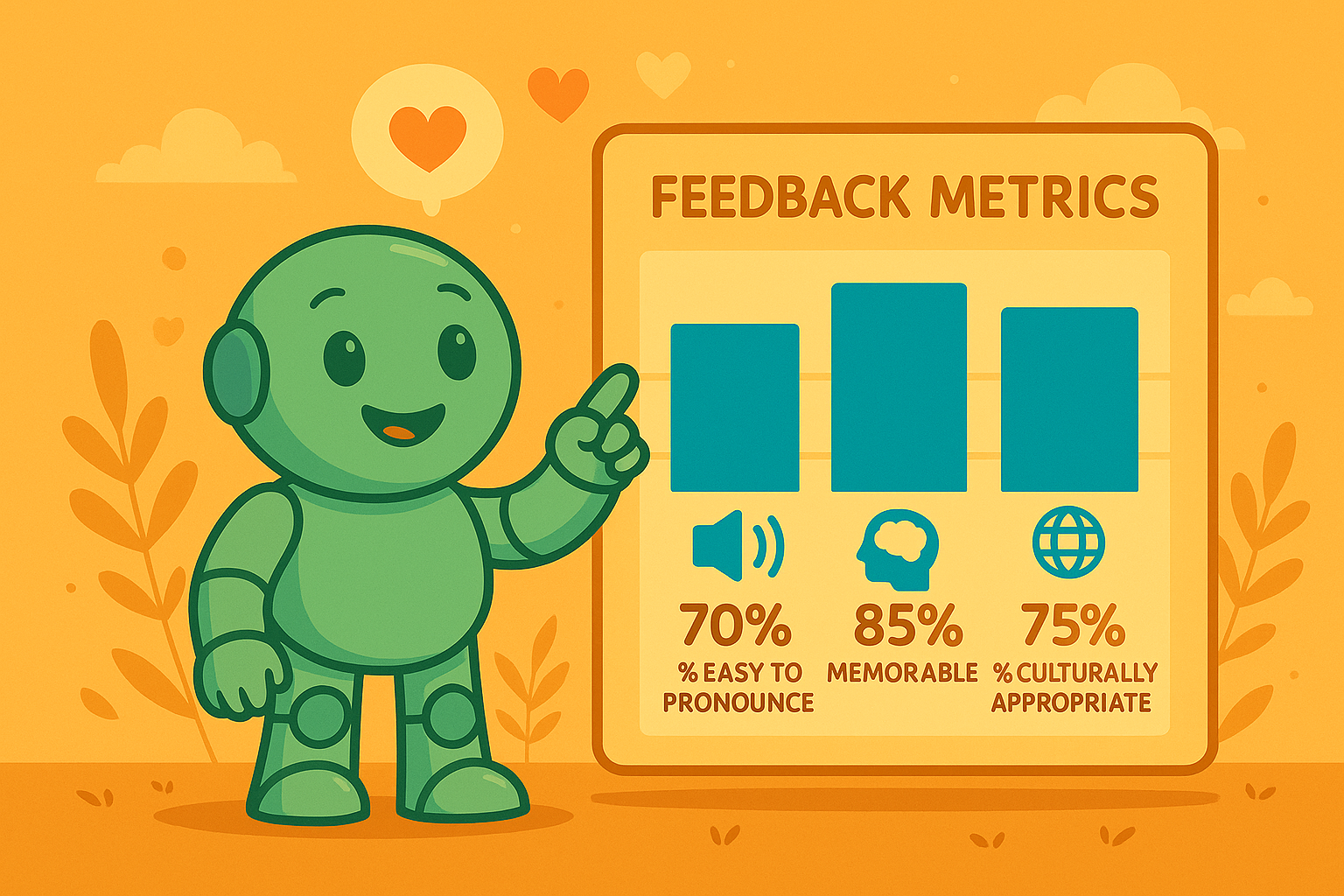How to Name a Character: Your Complete Storytelling Guide
Why Character Names Shape Your Reader's Entire Experience

A character's name is constantly at work, either enhancing or detracting from your story. It serves as a first impression, a label instantly connected to personality, background, and potential. This initial perception significantly influences how readers engage with your characters and, ultimately, your entire narrative. A well-chosen name can captivate readers, while a poorly chosen name can create distance and even undermine believability. So, how do you choose names that truly resonate?
A character's name plays a vital role, often reflecting personality, background, or societal standing. Consider the name "Hortense." It might conjure images of a stern, older woman, perhaps a strict governess. In contrast, "Kymberly" might suggest a bubbly teenager. While subjective, these immediate associations demonstrate how names instantly signal different personality expectations. Names can symbolize various facets of a character's identity, like ethnicity, social status, or personal traits. Learn more about the nuances of naming characters here.
The Psychology of Names
The psychological impact of names is significant. Think of it as branding: a product's name influences consumer perception. Similarly, a character's name influences reader perception and engagement. It can evoke emotions, create familiarity, or even foreshadow destiny. This is where naming a character becomes a powerful storytelling device.
Names as Storytelling Tools
Skilled authors use names to foreshadow character development, hint at hidden backstories, and create memorable impressions. For instance, a character named "Phoenix" might suggest a journey of rebirth. A character named "Shadow" could hint at a darker, mysterious side. These subtle cues enrich the reading experience and add layers to the narrative.
Crafting Unforgettable Character Names
The key difference between a memorable and forgettable character name often lies in the author's intent. By understanding the psychology of names and using them strategically, authors can craft names that not only suit their characters but also enhance the overall narrative. This means looking beyond simple labels and considering the deeper meaning and associations a name holds. How does your character's name contribute to their journey, relationships, and the story's themes? The answer to this question will guide you in crafting truly unforgettable names.
Navigating Cultural Naming Traditions Without Losing Authenticity

Crafting believable and relatable characters often depends on the authenticity of their names, particularly when portraying individuals from diverse cultural backgrounds. This requires careful consideration of how different cultures approach the practice of naming and the deeper meanings embedded within those traditions. By exploring these nuances, we can develop characters that resonate with a broader audience while avoiding cultural missteps.
Researching Cultural Naming Conventions
Authenticity in character naming starts with diligent research. For instance, in many Asian cultures, names are chosen based on their inherent meaning. A closer examination reveals that approximately 80% of parents in these cultures select names that signify positive attributes like good fortune or prosperity. This differs significantly from some Western naming conventions, which may emphasize family history or simply the pleasant sound of a name. Globally, naming trends play a role in how fictional characters are perceived and how their stories unfold. As of 2023, about 50% of parents in the U.S. indicate they select names with cultural or historical significance. This highlights a growing awareness of cultural sensitivity in naming, even outside of creative writing. To learn more about global naming trends, visit this insightful article: Character 101: Naming the World. For practical advice on navigating diverse naming practices, see this helpful resource: How to Master Diverse Naming Practices.
Avoiding Appropriation and Stereotypes
While honoring cultural significance is paramount, it's equally vital to steer clear of appropriation and harmful stereotypes. This requires a nuanced understanding of the line between respectful representation and caricature. One effective strategy is to consult with sensitivity readers or cultural experts. Their valuable insights can help identify potential issues and ensure your character names are both culturally accurate and avoid perpetuating negative stereotypes.
Creating Authentic Names in Fictional Worlds
Creating believable names for characters in fictional worlds presents unique considerations. However, the same principles of thorough research and cultural sensitivity apply. Carefully consider the cultural influences within your created world. If your world draws inspiration from medieval Japan, for example, research Japanese naming conventions specific to that historical period. Adapting real-world practices can enrich your fictional cultures and add a layer of believability to your characters.
Balancing Authenticity and Accessibility
Balancing authenticity with accessibility for readers is an important aspect of character naming. While accuracy matters, overly complex or unfamiliar names can hinder a reader’s engagement with the story. Striking a balance between cultural significance and ease of pronunciation is key. One technique is to incorporate familiar sounds or structures from the chosen culture while simplifying or adapting them for a wider audience. This allows readers to connect with the characters without being unduly distracted by challenging names.
Techniques for Cross-Cultural Naming
Developing names that feel authentic across different cultural contexts requires careful thought about your target audience and the story’s setting. One approach is to use names that are pronounceable in multiple languages. Another technique involves creating names that evoke the sounds or rhythms of the chosen culture without being direct translations. This can create a sense of authenticity without alienating readers unfamiliar with the specific language. By thoughtfully considering these elements, you can craft names that enhance your characters’ identities and contribute to a more immersive reading experience.
Learning From Authors Who Master Diverse Character Naming
Contemporary literature is increasingly filled with culturally diverse and nuanced character names. This presents both exciting opportunities and unique challenges for authors. Some writers navigate this new landscape with impressive skill, while others struggle. This section explores the techniques used by literary masters like Toni Morrison and Jhumpa Lahiri, who excel at integrating the complexities of naming into their character development, particularly when exploring themes of identity and belonging.
Balancing Authenticity With Accessibility
Morrison and Lahiri demonstrate a deep understanding of how names act as symbols of cultural identity. They go beyond simply choosing names that sound culturally appropriate; instead, they select names with specific meaning and weight within their respective cultural contexts. This involves researching the history, etymology, and cultural significance of names. However, they carefully balance this authenticity with accessibility. While rich with cultural meaning, their chosen names remain pronounceable and memorable for a diverse readership. This balance ensures that the names enhance, rather than detract from, the narrative. For example, in Morrison's Beloved, the protagonist's name carries the weight of her tragic past, underscoring the dehumanizing effects of slavery. Similarly, in Lahiri's The Namesake, the protagonist grapples with his culturally specific name and how it shapes his sense of self in a new environment.
This thoughtful approach avoids the pitfall of exoticism, where names become mere symbols of "otherness." Morrison and Lahiri use names to ground their characters in specific cultural realities, making them feel more genuine and relatable. This is key to forging a strong connection with the reader, as it reflects the author's respect for the cultures represented. This meticulous attention to detail enriches the reader's immersive experience, deepening their understanding of the characters and their internal lives.
Honoring Cultural Significance
These authors don't shy away from portraying how names can be sources of both pride and conflict for their characters. Many of their characters wrestle with the tension between their given names and the identities they create for themselves in a complex world. This internal conflict, often reflected in external struggles with societal expectations, adds depth and realism to the narrative. The evolution of names in literature is a significant area of study, with approximately 60% of works by authors like Toni Morrison and Jhumpa Lahiri featuring characters experiencing identity crises connected to their names. Furthermore, there has been a reported 25% increase in the use of culturally diverse names in fiction over the last decade. Learn more about this fascinating topic here.
Strategies for Effective Character Naming
A key strategy both authors employ is allowing the narrative itself to reveal a character's name’s significance. Rather than explicitly explaining the meaning behind each name, they weave this information into the story, allowing readers to discover these connections organically. This subtle approach enhances the reading experience, rewarding careful readers with a richer understanding of the character's motivations and journey. This also avoids interrupting the narrative flow with unnecessary explanations. Instead of telling, they show, using the story's power to illuminate the meaning and importance of each carefully chosen name.
Another important aspect is how these authors use names to foreshadow character development. This might involve a character taking on a new name or reclaiming their birth name, signaling a pivotal shift in their self-perception and relationship with their cultural heritage. This subtle foreshadowing adds another layer of complexity to the story, creating a more engaging and thought-provoking experience for the reader. By considering how names can evolve throughout the narrative, these authors further demonstrate the powerful connection between names, identity, and personal growth. These character naming techniques are invaluable for writers seeking to craft rich, believable characters whose names resonate with readers long after the book is finished.
Matching Names to Genres That Actually Work for Readers
Genre significantly influences the style and tone of character names. A mismatch can disrupt reader immersion and suggest amateur writing. Whether crafting a hard-boiled detective or a whimsical fairy, the naming approach should align with reader expectations. This section explores how to create names that enhance, not hinder, your story.
Genre-Specific Naming Conventions
Each genre possesses unwritten rules regarding character names. A fantasy epic might require names that evoke an ancient, otherworldly feel, while a contemporary romance benefits from familiar, relatable names. Accuracy in this area adds authenticity, making the fictional world more believable and engaging.
Let's explore the varying naming strategies across genres in the following table:
Character Naming Strategies by Genre A comprehensive comparison of naming approaches across different literary genres, including examples and key considerations for each type.
| Genre | Naming Strategy | Example Names | Key Considerations |
|---|---|---|---|
| Fantasy | Evocative, often drawing from mythology or invented languages | Elara, Aric, Zephyr | Pronounceability, avoiding clichés |
| Science Fiction | Futuristic, sometimes using unusual combinations of letters and sounds | Xylos, Anya-Prime, Jax-7 | Conveying technological advancement, uniqueness |
| Historical Fiction | Authentic to the time period and cultural setting | William, Elizabeth, Anne | Accuracy, reflecting social status |
| Crime/Thriller | Often short and memorable, sometimes hinting at the character's nature | Jack, Mia, Victor | Avoiding overly dramatic or stereotypical names |
| Romance | Generally familiar and appealing | Liam, Emma, Noah | Reflecting character personality and relationship dynamics |
This table highlights how names contribute to the overall atmosphere of each genre. From the fantastical to the familiar, choosing the right name is a vital step in crafting compelling characters.
Creating Cohesive Naming Systems
Consider developing a consistent naming system within your fictional world, especially in fantasy and science fiction, where you might be creating entire cultures with unique linguistic patterns. Perhaps all names within a specific tribe share a prefix or suffix. This consistency strengthens world-building and enhances realism.
Examples of Genre-Specific Naming
-
Noir Fiction: Short, punchy names like "Jack" or "Lola" capture the genre's gritty realism.
-
Children's Literature: Whimsical names like "Tinkerbell" or "Willy Wonka" complement the lighthearted and imaginative stories.
-
Literary Fiction: More complex names, often with symbolic meaning, align with the genre's focus on character development and thematic depth.

This infographic visualizes feedback metrics on test names, including pronounceability, memorability, and cultural appropriateness. Balancing these factors can be challenging. Name A scored high on pronounceability but lacked memorability. Name B was memorable but fell short on cultural appropriateness. Name C performed well across all three metrics.
Balancing Creativity and Convention
While creative naming is encouraged, avoid becoming so unconventional that it distracts from the story. Names should feel natural within the genre and avoid sounding contrived or overly symbolic. Strive for balance between creative expression and genre conventions to create names that resonate with readers and enhance your narrative. By exploring these techniques and using resources like NameRobot, you can create compelling character names that add depth and meaning. Explore further inspiration techniques available on NameRobot to refine your naming process. This ensures your characters' names are as captivating and well-crafted as the stories they inhabit.
Embedding Symbolism That Rewards Your Most Attentive Readers

Truly captivating character names possess a hidden depth, subtly enriching the narrative. This involves strategically embedding symbolism, irony, and even foreshadowing within the names themselves. Such an approach adds layers of complexity to the story, rewarding attentive readers with a deeper understanding and a sense of discovery.
Utilizing Etymology, History, and Wordplay
A character's name can be a wellspring of meaning, alluding to their personality, destiny, or role within the narrative. Imagine a character named "Arthur," a name resonating with Arthurian legends and hinting at a potential for greatness. This subtle connection adds a layer of intrigue. Etymology also plays a crucial role. Consider a character named "Marcus," derived from Mars, the Roman god of war. This choice could symbolize the character's internal struggles and conflicts. For more insights into the power of names, explore resources like How to Master the Art of Using Synonyms in Character Naming.
Crafting Multi-Layered Names
Wordplay offers another avenue for imbuing names with symbolic weight. A character known for their sharp wit could be named "Pierce," subtly referencing their piercing humor. Historical figures can also serve as inspiration. A character embodying resilience might be named "Nelson," evoking the strength and perseverance of Admiral Nelson. These multi-layered names create a richer reading experience, encouraging readers to delve deeper into the nuances of the story.
Balancing Symbolism and Readability
While symbolism is important, it should never compromise readability. Names should flow smoothly within the dialogue and be easy to pronounce. A complex, difficult-to-pronounce name can disrupt the flow of the narrative and hinder immersion. For example, while a name like "Seraphina" might evoke angelic beauty, its complexity could pose a challenge for readers during dialogue. Finding a balance between symbolic richness and ease of pronunciation is paramount.
Testing the Effectiveness of Your Symbolic Choices
Ultimately, the success of symbolic names hinges on their integration within the story. Do they enhance the narrative or create a distraction? Gathering feedback from readers is crucial. Ask them about the names' resonance, their fit with the characters, and any perceived symbolic meanings. Consider a character associated with nature named "Willow," evoking images of grace and flexibility. However, if this character is portrayed as rigid and unyielding, the name's symbolism clashes with their personality, potentially weakening the narrative. Ensuring alignment between symbolic choices, character traits, and narrative roles is key to creating a cohesive and impactful story.
Testing Your Names Before Your Readers Do the Work for You
A character's name is a crucial element of storytelling. Even a name crafted with symbolic meaning and careful consideration isn't truly finished until it's been tested. This means going beyond your own perspective and seeking external feedback. This process ensures your names resonate with readers, enhance your narrative, and improve the overall reading experience.
Gathering Meaningful Feedback
Beta readers are essential for testing character names. However, simply asking for opinions can result in biased responses. Instead, ask indirect questions that reveal a name's impact. For instance, ask readers to describe a character's personality based solely on their name. This determines if the name aligns with your intended portrayal. Presenting readers with different names for the same character description and asking which fits best is another effective strategy. This helps gauge how well a name conveys key character traits.
Testing Pronunciation and Readability
Testing name pronounceability across diverse audiences is vital. A seemingly simple name might be difficult for readers with different linguistic backgrounds. Read-aloud sessions with beta readers can identify pronunciation problems. This also helps evaluate the name's readability and how it flows within dialogue. An elegant name on paper might sound awkward when spoken.
Assessing Alignment With Character Development
Does the name enhance or hinder character development? This is a key question to address through reader feedback. A name that initially seemed perfect might clash with a character's evolving personality or story arc. For example, a character initially portrayed as shy might become a courageous leader. A delicate name could then undermine this transformation. Tracking reader reactions to names throughout the story ensures continued alignment.
Identifying and Addressing Common Naming Mistakes
Certain naming mistakes can immediately impact a story's credibility.
-
Too Many Similar Names: Characters with similar names confuse readers. For example, "Mark," "Marcus," and "Marco" in the same story could easily lead to confusion.
-
Overly Symbolic Names: While symbolism is powerful, it should be subtle. Overly symbolic names can feel forced and distracting.
-
Culturally Inappropriate Names: Using names from unfamiliar cultures without research can be offensive.
Ensuring Appropriate Name Diversity
Creating a diverse cast of characters requires careful consideration of names. Avoid stereotypes and tokenism. Research the cultural background of names to ensure accurate representation. Diverse naming should enrich your story, reflecting the complexity of human experience. Resources like NameRobot offer insights into diverse naming practices.
Strategies for Making Name Changes
Don't hesitate to change a name if testing reveals it isn't working. However, be strategic. Introduce the new name clearly and consistently. A brief in-story explanation for the change can be helpful if it fits the narrative. This avoids confusion and maintains the story's flow.
Character Name Evaluation Checklist
This table provides a framework for evaluating and refining character names:
| Evaluation Criteria | Questions to Ask | Red Flags | Refinement Tips |
|---|---|---|---|
| Memorability | Is the name easy to remember? Is it distinct? | Readers consistently misremember or confuse the name. | Shorten the name, use a unique spelling, or add a nickname. |
| Cultural Sensitivity | Is the name culturally appropriate? Does it avoid stereotypes? | The name feels offensive or inaccurate. | Conduct research, consult sensitivity readers, consider alternatives. |
| Story Integration | Does the name fit the character's personality, background, and role? | The name clashes with the character's development or story's tone. | Refine the name to better align with character traits and themes. |
| Pronunciation | Is it easy to pronounce? Does it flow in dialogue? | Readers struggle with pronunciation, or it sounds awkward. | Simplify spelling, provide pronunciation guides, consider a different name. |
Testing your character names ensures they contribute to an engaging reading experience. Tools like NameRobot offer resources for generating creative and effective character names.















